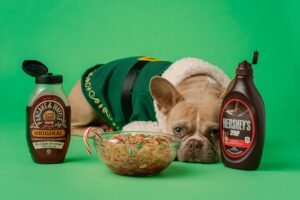The holidays are a wonderful time for baking, decorating your home, family gatherings, and celebrating. Unfortunately, during the holiday season veterinarians see an increased number of toxicity cases. Here are the most common toxin exposure risks during the holiday season.
Chocolate: Chocolate can cause serious GI issues, hyperactivity, abnormal heart rates and arrhythmias, as well as neurologic side effects like seizures. Don’t be surprised if your dog can sniff out even the most concealed chocolate that is in a box wrapped under the Christmas tree!

Grapes, raisins, or currants: Watch out for these in fruit cakes, bread, and cookies. Even just a couple of grapes, raisins, or currants can be enough to pose a risk for kidney failure!
Alcohol: A lick or two of an alcoholic beverage is unlikely to pose a risk for severe alcohol toxicity in our pets. We actually see alcohol poisoning more commonly when a pet ingests an alcohol-soaked baked good, chocolates/candies with alcohol inside, or unbaked dough containing yeast. Alcohol toxicity can cause dangerously low blood sugar, low blood pressure, low body temperature, seizures, and respiratory depression. Unbaked dough containing yeast (which will ferment into alcohol) can be especially dangerous because the dough will continue to rise in the pet’s stomach which can pose a risk for not only alcohol toxicity but also a dangerous condition called Gastric Dilatation-Volvulus (commonly called bloat or twisted stomach). This is a life-threatening condition that requires immediate medical attention.
Xylitol: Xylitol is a sweetener that is toxic to dogs, is often used in baking, and can be found in many products including many sugarless gums, mints, candy, vitamins, toothpaste, and even in some products like deodorant. Even a small amount of xylitol can cause detrimental effects to our dogs’ blood sugar levels and livers.
Holiday plants (poinsettia, lilies, holly, mistletoe):
- Poinsettias are mildly toxic, typically only posing a risk for mild GI upset.
- Lilies are not as much of a concern for our canine friends as they are for our felines. Even a couple of licks of a lily can pose a risk for kidney failure in our cats. Dogs may experience mild GI upset if a large amount is ingested.
- Ingestion of holly can result in severe GI upset.
- Mistletoe can pose a risk for GI upset in small amounts. However, if large amounts are ingested symptoms such as low blood pressure, collapse, ataxia (wobbly walking), and seizures can develop.

Liquid potpourri, essential oils, or candles: Many potpourris and essential oils can pose a risk for chemical burns to the mouth or skin as well as a wide variety of symptoms depending on the oil. Some oils can pose a risk for vomiting, muscle tremors, difficulty breathing, lethargy/weakness, and even organ damage. Cats tend to be most sensitive but these products can also be dangerous for dogs. The biggest concern with candles is the risk of burns, GI upset, and foreign body obstruction if a large amount of the candle is ingested.
Holiday ornaments or decorations: Most holiday ornaments/decorations are non-toxic but can pose a risk for GI irritation and foreign body obstruction of the intestinal tract if ingested. However, some old-fashioned holiday lights contain chemicals that can be dangerous to our pets. Homemade salt dough ornaments can be especially tempting for our dogs and the high salt content can pose a risk for serious toxicity. Elevated sodium levels can result in significant neurological abnormalities.
Ice melt: Many ice melts contain a large amount of salt or sodium chloride. Exposure to these products can cause irritation to the paws and skin, and ingestion can cause GI upset with small amounts. If a large amount of ice melt is ingested, more serious salt toxicity can occur. Signs such as excessive thirst, vomiting, and severe neurologic symptoms may develop.
If you suspect your pet has been exposed to a toxic substance, contact your veterinarian or a pet poison control service immediately!




